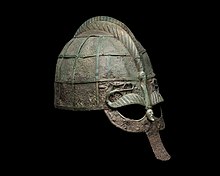This article needs additional citations for verification. (December 2020) |
| History of Sweden |
|---|
 |
| Timeline |
|
|


In Swedish prehistory, the Vendel Period (Swedish: Vendeltiden; c. 540–790 AD) appears between the Migration Period and the Viking Age. The name is taken from the rich boat inhumation cemetery at Vendel parish church, Uppland. Unlike the preceding and succeeding eras, the Vendel Period left very few precious metal artifacts or runic inscriptions. Instead, it is extremely rich in animal art on copper-alloy objects. It is also known for guldgubbar, tiny embossed gold foil images, and elaborate helmets with embossed decoration similar to the one found at Sutton Hoo in England.[1]
During the period, Swedish expeditions began to explore the waterways of territories which later became Russia, Ukraine, and Belarus. The Elder Futhark writing system was abandoned in favor of the Younger Futhark, virtually simultaneously over the whole of Scandinavia. Some runestones survive, most notably those at Rök and Sparlösa, both from c. 800. Other written sources are few and hard to interpret: a few Icelandic sagas, the tale of Beowulf, and accounts from some southern European writers. Earlier Swedish historians tried to make use of these to create a coherent history, but this effort has largely been abandoned, and the period is now mostly studied by archaeologists.[2]